Crystal structure of Fc gamma receptor I and its implication in high affinity gamma-immunoglobulin binding.
Lu, J., Ellsworth, J.L., Hamacher, N., Oak, S.W., Sun, P.D.(2011) J Biol Chem 286: 40608-40613
- PubMed: 21965667
- DOI: https://doi.org/10.1074/jbc.M111.257550
- Primary Citation of Related Structures:
3RJD - PubMed Abstract:
Fc¦Ã receptors (Fc¦ÃRs) play critical roles in humoral and cellular immune responses through interactions with the Fc region of immunoglobulin G (IgG). Among them, Fc¦ÃRI is the only high affinity receptor for IgG and thus is a potential target for immunotherapy. Here we report the first crystal structure of an Fc¦ÃRI with all three extracellular Ig-like domains (designated as D1, D2, and D3). The structure shows that, first, Fc¦ÃRI has an acute D1-D2 hinge angle similar to that of Fc¦ÅRI but much smaller than those observed in the low affinity Fc¦Ã receptors. Second, the D3 domain of Fc¦ÃRI is positioned away from the putative IgG binding site on the receptor and is thus unlikely to make direct contacts with Fc. Third, the replacement of Fc¦ÃRIII FG-loop ((171)LVGSKNV(177)) with that of Fc¦ÃRI ((171)MGKHRY(176)) resulted in a 15-fold increase in IgG(1) binding affinity, whereas a valine insertion in the Fc¦ÃRI FG-loop ((171)MVGKHRY(177)) abolished the affinity enhancement. Thus, the Fc¦ÃRI FG-loop with its conserved one-residue deletion is critical to the high affinity IgG binding. The structural results support Fc¦ÃRI binding to IgG in a similar mode as its low affinity counterparts. Taken together, our study suggests a molecular mechanism for the high affinity IgG recognition by Fc¦ÃRI and provides a structural basis for understanding its physiological function and its therapeutic implication in treating autoimmune diseases.
Organizational Affiliation:
Structural Immunology Section, Laboratory of Immunogenetics, NIAID, National Institutes of Health, Rockville, Maryland, USA.




















